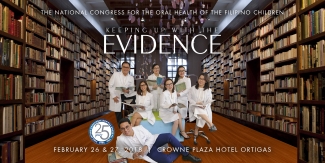Keeping Up with the Evidence
Speakers and Lectures

Dr. Gianina Camille Gamboa-Garcia
EVIDENCE #1 - Pulp Treatment of Primary Teeth

Dr. Manuel Vallesteros
Dr. Manuel Vallesteros is best known for his heavyweight lectures packed with humor on the practice of pediatric dentistry. He is loved dearly for being straightforward and vocal about community programs conducted by local chapters, with emphasis on proper oral health promotion and levels of pediatric health care.
A shortlist of his countless achievements include:
- Outstanding Alumnus of the Century For Public Service (1915-2015) awarded by UP Manila College of Dentistry (UPCD) and UP Dental Alumni Association (UPDAA)
- First Prize Winner, and Fourth International Recognition Award by the International Association of Pediatric Dentistry for the Bright Smiles Bright Futures Award Program awarded in 2005 and 2001, respectively
- Recognized as the Most Outstanding Affiliate Society President for the Philippine Pediatric Dental Society, Inc (PPDSI), and in Academe, by the Philippine Dental Association in 2001 and 2000, respectively
For the longest time, Dr. Noel has been the Chairman of the Philippine Dental Association Awards Committee, an avenue where locally appropriate and culturally sensitive community programs are recognized. Currently, he is the Chairman of the Public Health Committee of the PPDSI. He is preoccupied brainstorming with the nation’s oral health advocates for programs to address the oral health needs of children, especially those with special health care needs in this time of pandemic.
EVIDENCE #2 - Silver Diamine Fluoride
EVIDENCE #3 - Social Determinants of Oral Health
SDF-SDH: SMILING TANDEM: A CHILD-CENTRED DENTISTRY FROM A NON-TRADITIONAL PERSPECTIVE
The introduction of silver diamine fluoride (SDF) almost a decade ago was to address the unmet oral health needs of disadvantaged children, in the spirit of social justice and health equity in developing countries like the Philippines. After thorough research and investigation, the American Academy of Pediatric Dentistry (AAPD) finally released a policy statement approving its use for caries control in children. At the same time, AAPD also released a policy on SDH or Social Determinants of Oral Health as a major consideration when formulating treatment plans and community health programs for children. The updated use of SDF within the context of SDH in addressing the caries problem will be fully discussed in this lecture.

Yvonne Vanessa Chua, DMD, MBAH
- President, Philippine Society of Periodontology
- Certificate in Advanced Periodontics and Implantology, New York University, College of Dentistry
EVIDENCE #4 - Periodontal Disease in the Young - Do They Matter?
All too common, gingival concerns may happen earlier than expected by young patients. All too often, gingival inflammation is dismissed as just having poor hygiene awareness. This is precisely why oral health awareness has to be approached with a wellness point of view by both patient and the attending dentist. This provides for a better understanding of how oral hygiene awareness helps an individual understand oral health, in relation to an individual’s overall health status.
This lecture will tackle the different concerns a dentist must provide their patients, in terms of awareness, starting with symptomatic, as well as, asymptomatic presentations of gingival inflammation, and how these conditions, without definitive interventions, may continue throughout a patients lifetime, into their adulthood, producing complications that could lead to more pronounced and progressive periodontal conditions.

Piranit Kantaputra, DDS, MS
- Center of Excellence in Medical Genetics Research, Division of Pediatric Dentistry, Chiang Mai University, Thailand
- Fellowship in Clinical Genetics and Dysmorphology, University of Minnesota
- Master of Science (M.S.) University of Minnesota
- Certificate in Pediatric Dentistry, University of Minnesota
- Doctor of Dental Surgery (D.D.S.) Chiang Mai University, Thailand
EVIDENCE #5 - Tooth and It's Genetic Syndrome
A number of dental patients have genetic disorders which may have systemic involvements such as congenital heart diseases and brain disorders. The ability to recognize if your patients have genetic syndromes is beneficial for your clinical practice and the understanding of human development. Patients with Microcephalic Osteodysplastic Primordial Dwarfism type II have been reported to have the smallest teeth in the world and some of them have been reported to have strokes at very young ages. The syndromes of the biggest teeth in the world and the longest roots will be presented. Patients with Amelogenesis Imperfecta, hypoplastic type may have nephrocalcinosis or kidney stones if they have mutations in FAM20A. This syndrome is known as “Enamel-Renal-Gingival Syndrome”. The lecture will cover common genetic syndromes and how to recognize them. The syndromes that will be included are Holoprosencephaly, X-linked hypohidrotic ectodermal dysplasia, Ellis-van Creveld syndrome, Rapp-Hodgkin syndrome, AEC syndrome, and Van der Woude syndrome etc. This lecture will demonstrate how teeth can be used in syndrome diagnosis and how rare craniofacial and tooth syndromes help us to understand human biology.

Rumpa Wig, DDS
- Govt. College of Dentistry, Indore, India
- Certification in Aesthetic Dentistry, New York University, USA
- Vice-President, Board of Indian Academy of Aesthetic and Cosmetic Dentistry
EVIDENCE #6 - Bioactive Permanent Restorations
Kids are our future! Pediatric Dentistry involves basic treatment protocols to the complex restorative situations. Let us take a walk through the latest innovations in dentistry that help us to make our lives simpler, heal and seal the tooth, work with longer lasting result, do a restoration that remains active and deliver a healthy and bioactive material to our gen-next brigade.
Dental caries prevention's most challenging aspect is caries control. Sealants and fluoride varnish are two materials that helps this. We need a "smart" material that loves tooth structure, integrates and penetrates and intimately adapts to tooth structure, appears to melt into the enamel, margins are undetectable and a rubberised resin molecule that adds remarkable toughness. It would be also ideal if the restoration releases and recharges significant calcium, phosphate and fluoride in the oral environment, fortifies the saliva with essential tooth-building minerals and stimulates apatite formation, forms a bond and seal against microleakage and secondary caries and helps to repair teeth during rising pH cycles.

Adam Au, BDS (HK), M Paed Dent RCSEd, MRACDS (Paed), M Paed Dent RCS (Glasg)
- Fellow, Royal Australasian College of Dental Surgeons
- Fellow, College of Dental Surgeons of Hong Kong (Pediatric Dentistry)
- Fellow, Hong Kong Academy of Medicine
- Fellow, Royal College of Surgeons of Edinburgh
EVIDENCE #7 - Minor Surgical Procedures in Pediatric Dentistry
Childhood and adolescence are characterized by eruption and shedding of primary teeth and eruption of permanent teeth. These complicated processes may require surgical interventions in order to secure a normal dentoalveolar development. Dental anomalies (e.g. supernumerary teeth and odontomas) also often require surgical corrections during childhood and adolescence. Other examples of conditions requiring surgical intervention are soft tissue anomalies and oral mucosal lesions, such as ankyloglossia, thick labial frenum and mucocele.
Expertise in modern methods of pain control, and in particular, use of sedation is an absolute requirement for a successful outcome. During this presentation, examples of clinical cases, with special aspect, by using Soft Tissue Laser will be shown.
On the other hand, clinicians, e.g. oral surgeons or pediatric dental specialists seem to substantiate their decisions on their experience and low-evidence data. Second part of this presentation will illuminate these aspects and identify evidence-based information provided by scientific literatures.

Teacher Monica Javier
- Master’s Degree, Development Education, University of the Asia and the Pacific
- Kinder and First Grade Coordinator, Keys School Manila, Mandaluyong City
- Pre-school Teacher, Explorations Pre-School
EVIDENCE #8 - Communicating with Children
A lot of children experience anxiety when visiting a dentist. Children with special needs may have higher levels of anxiety caused by a number of factors like the fear of the unknown and not being able to communicate their thoughts and feelings.
A visit to the dentist is a very sensorial activity as well and children with special needs are highly sensorial. There are a lot of things that we can do to help prepare these kids and their families to turn their visit into a more positive experience. We can work on behavioral and environmental techniques to lessen anxiety and eventually increase cooperation.

Jonalyn Chris Ang, MD, DPPS, FPNA, FCNSP, FPSSM
- Chair, Philippine Board of Sleep MedicIne, Philippine Society of Sleep Medicine
- Clinical Neurophysiologist, Brain and Spine Center, Cardinal Santos Medical Center
EVIDENCE #9 - Pediatric Obstructive Sleep Apnea and It's Dental Perspective
Pediatric Osbstructive Sleep Apnea (OSA) is a chronic pathological condition associated with a wide range of clinical symptoms, historical evidence, dentofacial physical examination findings, environmental components and genetic and/or epigenetic factors. Pediatric OSA is clearly linked with neurocognitive impairments such as Attention Deficit Hyperactivity Disorder (ADHD) and other behavioral disorders.
Many of the various physical characteristics associated with pediatric OSA are also strongly associated with a number of pediatric dentofacial abnormalities. The relationship of the developing jaws and facial structures and pediatric OSA is also well described.
Orthodontists, pediatric dentists and general dentists should collaborate with efforts to raise awareness, among themselves and their patients, about the importance of early recognition of pediatric patients who may be at risk for sleep disordered breathing, such as obstructive sleep apnea.

Rosa Maria Hipolito-Nancho, MD, FPPS, FPSAMS, IFePag
- Center Chief, Center for Adolescent Medicine, Philippine Children’s Medical Center
- President, Philippine Society of Adolescent Medicine Specialists, Inc.
- Fellow, International Federation in Pediatric & Adolescent Gynecology
EVIDENCE #10 - Substance Abuse
EVIDENCE #11 - Pregnancy Among Adolescent
Adolescence is a growing population in the Philippines with a total of 21% of the total population between the ages 10 -19 years of age. This growing population, though considered one of the healthiest age group, is beset with its own unique set of problems usually emanating from risky behaviors. Among them are: Teen pregnancy and substance abuse. This lecture will tackle these two major issues from the dentists point of view since you are considered a front liner in the care of teenagers. Our objectives are: 1) To provide an overview of the health situation of teens in the country; 2) to provide tips on how to approach adolescents in the clinic, emphasizing on the issues of confidentiality and consent; 3) to discuss some principles in the management of teens who are pregnant and/or using drugs. Equipping the primary dental physician with skills in thorough history taking and brief physical examination may be helpful in ensuring that the adolescent will be managed thoroughly and adequately.

Rodelia Cipriano, MD
- Visiting Fellowship Training in Pediatric Intensive Care at Johns Hopkins Medical Center, Baltimore, Maryland
- Fellow, Philippine Pediatric Society
- Fellow, Society of Pediatric Critical Care Medicine Philippines
- Fellow, Philippine Society of Critical Care Medicine International Associate of the Society of Critical Care Medicine
- Medical Specialist III and Training Officer, Pediatric Critical Care Center, Philippine Children's Medical Center (PCMC)
- Immediate Past President, Society of Pediatric Critical Care Medicine, Philippines
